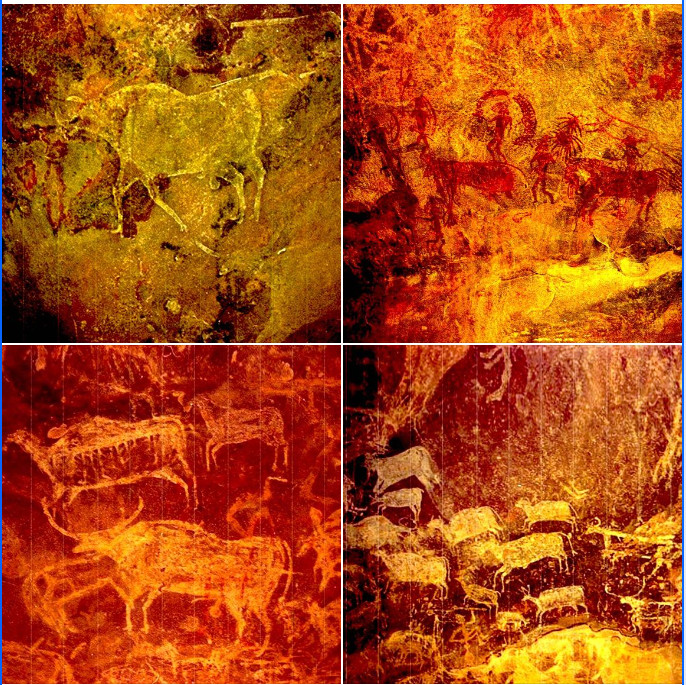Nestled in the heart of central India, the Bhimbetka rock shelters stand as a captivating archaeological marvel that transports us back to the dawn of human civilization. Offers a remarkable glimpse into the artistic expressions and lifeways of our prehistoric ancestors who inhabited the Indian subcontinent over 100,000 years ago. The Bhimbetka rock shelters represent one of the earliest and most significant repositories of prehistoric rock art in the world, shedding light on the rich cultural heritage and innovative spirit of our distant forebears.
The Prehistoric Treasure Trove of Bhimbetka

Bhimbetka’s rock shelters, numbering over 700, were first discovered in the 1950s by archaeologist V.S. Wakankar. These natural rock formations, carved and sculpted by the elements over millennia, served as shelters and canvases for the artistic expressions of Homo erectus and later Stone Age inhabitants. The oldest rock paintings at Bhimbetka date back an astonishing 30,000 years, making them among the earliest known examples of human artistic endeavor in the region.
The rock art at Bhimbetka is remarkably diverse, encompassing a wide range of subjects and styles. Visitors can witness vivid depictions of animals such as bison, elephants, deer, and horses, as well as hunting scenes, ritual dances, and everyday activities like cooking and farming. The paintings showcase a remarkable attention to detail and an innate understanding of form and movement, reflecting the keen observational skills and creative prowess of the artists.
Uncovering the Mysteries of Bhimbetka

One of the fascinating aspects of Bhimbetka is the ongoing effort to unravel the mysteries surrounding its inhabitants and their artistic traditions. Archaeologists have uncovered evidence of human habitation at the site dating back over 100,000 years, with the earliest residents believed to be Homo erectus, our evolutionary ancestors. As the climate and environment of the region changed over millennia, the rock shelters were occupied by successive waves of Stone Age peoples, each leaving their unique imprint on the cave walls.
The uniformity of the rock art across the various shelters suggests a shared cultural tradition and a sense of community among the inhabitants. Researchers have also found evidence of early dance rituals, with figures in the paintings depicted in what appear to be choreographed movements. These discoveries offer valuable insights into the social, spiritual, and artistic practices of these ancient communities.
The Significance of Bhimbetka’s Rock Art

The significance of the Bhimbetka rock art extends far beyond its aesthetic appeal. These prehistoric paintings serve as a vital link to our collective human past, providing a tangible connection to the earliest stages of our species’ artistic and cultural development. The rock art offers a unique window into the daily lives, beliefs, and creative expressions of our distant ancestors, shedding light on the universal human desire to document, interpret, and celebrate the world around us.
Moreover, the Bhimbetka rock shelters have played a crucial role in shaping our understanding of the origins and evolution of human civilization in the Indian subcontinent. The site’s exceptional preservation and the wealth of archaeological evidence it has yielded have been instrumental in rewriting the narrative of South Asia’s prehistoric past, challenging long-held assumptions and opening new avenues of research and exploration.
Preserving the Treasures of Bhimbetka
In recognition of its immense historical and cultural significance, the Bhimbetka rock shelters were designated as a UNESCO World Heritage Site in 2003. This designation has helped to raise awareness and garner international support for the preservation and protection of this remarkable archaeological treasure.
However, the task of safeguarding Bhimbetka’s fragile rock art and ensuring its long-term survival remains an ongoing challenge. Factors such as natural weathering, human interference, and the impact of tourism pose constant threats to the integrity of the site. Concerted efforts by the Indian government, heritage organizations, and local communities are crucial in implementing effective conservation measures and promoting sustainable tourism practices that balance public access with the preservation of this irreplaceable cultural
legacy.

Conclusion: Embracing the Enduring Legacy of Bhimbetka
The Bhimbetka rock shelters stand as a testament to the enduring human spirit and our innate drive to create, express, and connect with the world around us. These prehistoric masterpieces, etched into the very fabric of the land, serve as a profound reminder of our shared origins and the unbroken thread that binds us to our ancestors across millennia.
As we continue to explore and unravel the mysteries of Bhimbetka, we are granted a rare and privileged glimpse into the lives, beliefs, and artistic expressions of our prehistoric forebears. This remarkable site not only enriches our understanding of the past but also inspires us to reflect on our own place in the grand tapestry of human civilization. By preserving and celebrating the enduring legacy of Bhimbetka, we honor the creativity, resilience, and ingenuity that have defined the human experience since the dawn of time.
